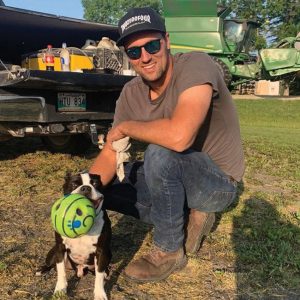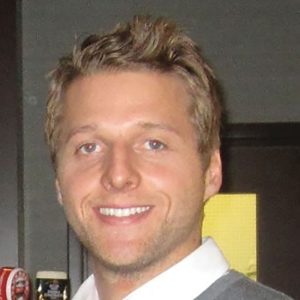
Features
Business
GroundBreakers
Meet the GroundBreakers
The honorees for the program’s inaugural year offer their perspectives on the future of drainage.
May 3, 2022 By Bree Rody
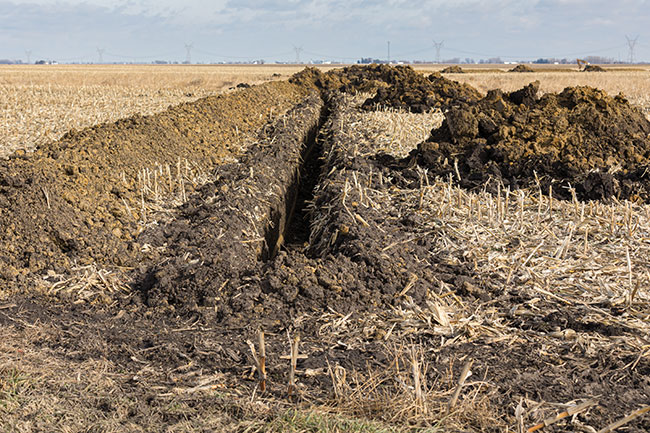 Photo credit: © JJ Gouin / Adobe Stock.
Photo credit: © JJ Gouin / Adobe Stock. In late 2021, Drainage Contractor launched the GroundBreakers, a recognition program to highlight and honor those in the industry who are moving drainage and water management forward.
After a tight judging race, five GroundBreakers were chosen from various roles within drainage and water management: Ditch Doctor owner Adam Fisher of Glenholme, NS; AGREM VP of water management Jeremy Meiners of Anchor, IL; Revasto Enterprises owner Matt Mroz of Beausejour, MB; NextGen Drainage Solutions CEO Brett Sheffield of Pilot Mount, MB; and PBS Water Engineering president and principal consultant Bruce Shewfelt of Morden, MB.
The honorees all play slightly different roles in the drainage space – some, like Mroz and Sheffield, work in the fields doing tiling. Others, like Meiners and Fisher, have focused on developing either equipment or technology solutions in order to bring more advanced solutions to drainage in our ever-changing world. Shewfelt, meanwhile, retired from his years in public service to launch his own consultancy firm specializing in subsurface drainage and irrigation. However, all are united by a passion for drainage, water management and improving the land for growers.
The visionary: Jeremy Meiners
It sounds like a familiar tale: Jeremy Meiners grew up on his family farm in Illinois and, along with his brothers, spent much of his childhood driving tractors, picking up rocks and helping out with the operations wherever he could. In the 1980s, his father founded AGREM, a software company for farmers and landowners that would later develop software that specialized more in drainage design – and today, Meiners is VP of water management for that company.
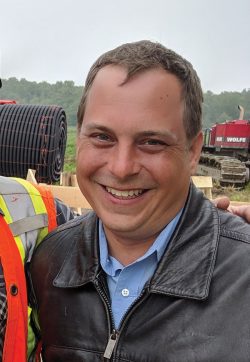 But Meiners’ path to that position was more meandering than direct, and in fact, he says, he wasn’t certain he wanted to go into agriculture at all when he first left home. “What my dad did… it was very exciting, but when I went to college, I didn’t exactly think I wanted to come back and work in agriculture.” He eventually went on to grad school and later obtained his PhD at Washington University in St. Louis. At the time, says Meiners, “the path for most people coming out of Washington was to go into academia.” But Meiners began to think about what kind of impact he wanted to make on the world. Around then, AGREM had recently developed software for designing subirrigation systems and controlled drainage systems on rolling topography. When he thought about his potential impact on the world, Meiners says that’s when it all became clear. “With agriculture, there’s a call to feed the world – how do we increase production so there’s plenty of food for everyone?” At the same time, he says this addressed the issue of conservation and preserving the environment.
But Meiners’ path to that position was more meandering than direct, and in fact, he says, he wasn’t certain he wanted to go into agriculture at all when he first left home. “What my dad did… it was very exciting, but when I went to college, I didn’t exactly think I wanted to come back and work in agriculture.” He eventually went on to grad school and later obtained his PhD at Washington University in St. Louis. At the time, says Meiners, “the path for most people coming out of Washington was to go into academia.” But Meiners began to think about what kind of impact he wanted to make on the world. Around then, AGREM had recently developed software for designing subirrigation systems and controlled drainage systems on rolling topography. When he thought about his potential impact on the world, Meiners says that’s when it all became clear. “With agriculture, there’s a call to feed the world – how do we increase production so there’s plenty of food for everyone?” At the same time, he says this addressed the issue of conservation and preserving the environment.
Despite working in technology and software, Meiners has been a “hands-on guy” from the start. Early in his career, he says, “Most of the time I found myself in the ditch learning the best way to make connections, to the point where my father actually said, ‘Jeremy, if I see you in that ditch one more time I’m not gonna let you come out with me to these field sites.’” He says that in the beginning, AGREM worked with contractors exclusively, but in the last decade, it has expanded to working with farmers who wanted to install their own tile, to see how they could guide them through such systems from start-to-finish. He says there are some farms that he knows like the “back of his hand,” a fact he attributes to his hands-on, connection-driven nature.
For Meiners, the best part about working in the field of drainage design is that drainage is not static, and that it can always be improved, whether that’s through new layout designs or methods such as combining surface and subsurface drainage. But what excites him most, he says, is working with new soil types.
“There’s over 1,000 soil types out there, and I’ve worked with so many, but now and then, particularly when you come to these glacial or erratic areas where there’s 100 different soil types on the field, it’s a process of figuring out how one type of soil might drain differently than the one right next to it and then making sure we can improve that field according to what the contractor wants.”
As passionate as he is about drainage and design, Meiners says it’s crucial to keep an eye on the future with regards to runoff, the solution to which needs to be a holistic approach. “The issue of the negative externality that our farming practices, particularly our fertilizer management, with tile drainage leads to a downstream effect and hypoxy issues in the Mississippi [River]. It’s a very serious situation in the Gulf of Mexico, and it’s going to take some major changes in terms of either fertilizer application or going to something like controlled drainage in order to resolve these without government intervention restricting applications.”
The advocate: Adam Fisher
If you like to use social media to chat with other drainage contractors, odds are you know Adam Fisher. Fisher, founder and owner of Ditch Doctor in Glenholme, NS, likes to partake in discussions of drainage, conservation and water management whenever he can in order to learn from others, make connections and advocate for better infrastructure management.
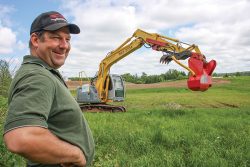 That passion started young for Fisher, whose father was a contractor who worked on drainage and other projects in the ’70s and ’80s. “Working with my father is what instilled the knowledge of the importance of draining the land and how to maintain it efficiently and effectively.”
That passion started young for Fisher, whose father was a contractor who worked on drainage and other projects in the ’70s and ’80s. “Working with my father is what instilled the knowledge of the importance of draining the land and how to maintain it efficiently and effectively.”
While most drainage issues focus on subsurface and tile drainage, Fisher’s specialization is in surface drainage – hence the name Ditch Doctor. He founded the company Ditch Doctor in 2002 when he built his first Ditch Doctor prototype. The product is an excavator attachment used to create, restore and maintain ditches, and is used as an alternative to using a bucket and trucking away spoil.
His work sees him frequently working with landowners, conservationists, engineers, operators and local government to educate them about drainage, ditches and ditch maintenance.
“Being able to maintain buffer zones and create two-stage ditches is our main mission,” he says. “We want to become a go-to method for maintaining the infrastructure.”
Getting the “good word” about drainage and drainage maintenance out is important to Fisher. He says when you step outside the drainage industry and into the broader infrastructure industry, drainage sometimes seems left out.
“It often seems to take a back seat to other issues that come up in agriculture, or even in civil or municipal issues. It’s almost similar to garbage infrastructure – pickup and delivery is a huge industry, but no one wants to talk about it.”
Currently, says Fisher, a number of challenges in the world of drainage mean more landowners are looking not only at surface-level solutions, but also at ways to implement those solutions more efficiently.
An increasing number of farmers in Canada and the U.S. have looked to enhancements to subsurface field drainage in an effort to manage the sudden influx of heavy rainfalls and mitigate potential soil erosion. Combination systems including two-stage ditches have been a popular recommendation. A two-stage ditch has a bottom channel for regular flows, bracketed by “grass steps” that extend back to stepped-back upper ditch walls to create a much larger channel for heavy water events. The extra space can help reduce flooding while also reducing nutrient and sediment loss to downstream water bodies by slowing the speed of the draining water. Fisher and his wife Carole have worked with their local agriculture college to support two-stage ditch studies.
Fisher says the environmental and economic factors currently at play are creating a golden opportunity for Ditch Doctor. “With prices of a lot of our goods increasing at unprecedented levels – fuel, oil, et cetera – I think we’re going to see a lot of people looking for different methods of doing a job, whether it’s maintaining infrastructure or putting food on the table. People want to be able to do it cheaper and faster.”
A recent study by the Association of Equipment Manufacturers found that there has been an 11.7 percent year-over-year increase in farm machinery prices, and with 81 percent of ag members reporting growth, demand for equipment is unlikely to slow down.
Fisher doesn’t intend on slowing down either. He is currently planning presentations on two-stage ditch methods with local civil engineering university courses, and has plenty of meetings booked with practicing engineers. The last two years of cancelled events and virtual meetings have been a “rollercoaster ride” for the extroverted Fisher, but he says there’s an urgency to get out there and discuss important drainage topics.
“You hear a lot of talk about phosphates and nitrates working their way into rivers and waterways around North America. It’s an issue that’s on everybody’s mind. There doesn’t seem to be a lot of traction on how to solve these issues. Implementing mandatory buffer zones on all waterways… it will filter out a lot of phosphates, a lot of nitrates.”
The collaborators: Brett Sheffield and Matt Mroz
Pilot Mount is a small town in Manitoba with only 700 residents. But quiet as it may seem, one of the companies there has made a name for itself. In 2019, NextGen Drainage Solutions was named one of Canada’s fastest-growing companies in Canadian Business.
The company, which was officially registered in 2012, placed 77th countrywide based on its five-year growth percentage. With more than two dozen employees, founder and CEO Brett Sheffield says it all comes down to precision, professionalism and pride.
“I’ve been very lucky to have some great mentors,” says Sheffield (pictured above left). This included Roger Ellingson, owner of the Minnesota-based Ellingson Companies, and Bob Clark II, owner of Indiana-based Clark Farm Drainage. “They took me and allowed me to work with them in the United States. The main thing they showed me is how important the quality of work was and how important installing things right the first time is. These products have to go in and last for decades.”
Although NextGen’s growth from two employees to two dozen in a few short years seems like a lot, Sheffield says it was all about being patient. “Rather than experiencing extreme growth early on, we really learned how to do it right. That’s how we became one of the fastest-growing companies in Western Canada – not just in drainage or agriculture, one of the fastest growing companies overall.”
NextGen offers turnkey services to customers – working with growers, surveying, tile drainage design, permitting and installation. With that holistic approach, it’s likely no surprise that Sheffield grew up on a farm.
While Sheffield still farms with his father Lyn to this day, between childhood and now, he also found himself intrigued by tile drainage. In 2010, he went back to school to complete his agricultural diploma course requirements of the University of Manitoba. It was in his soil classes where he learned the benefits of tile drainage. After doing his own research, Sheffield determined that tile drainage would be beneficial to his family’s 4,000-acre grain farm.
But Sheffield wasn’t one to keep a good thing to himself. “Not only could tile drainage benefit my farm, it could offer amazing benefits to farms in Western Canada.” He says in the last decade of owning a drainage firm, what he finds most gratifying is the immediate appreciation that farmers and customers demonstrate for the effects of drainage. “They see the incredible benefits that tile drainage and water table management brings to their land right away. It’s not as though we’re going to sell something that has no benefit. The benefit is clear. The excitement is there.”
On the surface, Sheffield has had a similar background to Matt Mroz, who both nominated Sheffield and ended up sharing in the GroundBreakers honor. Mroz, president of Revasto Enterprises, is a contracting partner for NextGen, and met Sheffield at the University of Manitoba in 2010. Like Sheffield, he grew up on a farm. Following his education, Mroz went to work for several years in the oil and gas industry in the hopes of making enough money to purchase land of his own and begin farming. Unfortunately, he says, land prices prevented him from doing so, but that led him down a different path. He went back to Manitoba and reconnected with Sheffield, who had been tiling for two years. Sheffield says he knew Mroz would make a great partner right away. “He does great quality work,” says Sheffield. “The two of us were really able to capitalize on
the market.”
While the two have similar backgrounds, Mroz says they also have unique approaches that allow them to go from strength to strength. “Brett has always been a little more business-minded,” says Mroz, who describes himself as someone who’s always really enjoyed equipment. He describes himself as a “farmer at heart” with fond memories of playing around with equipment as a child. In their early days being mentored by Clark and Ellingson, Mroz says Ellingson gave him words that helped him develop his level-headed approach. “He said, ‘there’s always more than one way to skin a cat.’ I don’t know why that one’s stuck with me, but sometimes things can get tough, and conditions don’t allow for things to go as well as they should. Step back, take a breath, reassess things.”
Both Sheffield and Mroz recognize that Manitoba is a unique market for drainage. Mroz says the variability in soil means there’s a good variety of challenges – where he lives, he describes the soil as “really heavy, tight clay,” but only 50 miles to the west in potato country, sand and light soils are dominant.
Sheffield adds that there’s less annual rainfall than where his mentors are based in the midwest. As a result, he says, “Our business is mainly targeting areas that are very wet and maybe smaller projects overall instead of whole fields.”
But the two also think one of the biggest barriers to true progress is government regulation. Sheffield says the government has been “changing regulations consistently,” and restriction such as when and where companies can tile are “constantly keeping us on our toes.”
The thought leader: Bruce Shewfelt
Bruce Shewfelt took early retirement from his position of chief of water and biosystems engineering at Agriculture and Agri-Food Canada in 2013. Shortly after, he launched his independent consultancy, PBS Water Engineering. He says with the new variety in jobs and projects for him, there’s no such thing as a “typical day.” “There’s sort of a cycle to it; it’s seasonal. Right now in the spring, we’re trying to finish up some designs. We’re finishing up a small dam – small, but expensive – and we’re getting ready to [purchase] some equipment for a drainage project I’m doing in Southwest Manitoba, and I’m procuring some equipment for a project monitoring stream flow, and we have three projects that we’re supposed to be writing environmental impact statements for. That’s half of what I’m doing.”
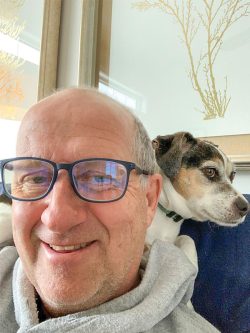 In summertime, he is more heavily involved in construction, whereas fall sees more investigation – “drill rigs, surveyors, ‘the dreaded’ report writing,” he jokes.
In summertime, he is more heavily involved in construction, whereas fall sees more investigation – “drill rigs, surveyors, ‘the dreaded’ report writing,” he jokes.
After finishing his master’s degree, Shewfelt began working for the Prairie Farm Rehabilitation Administration (PFRA) in Saskatchewan. After several years, he relocated to Morden, where he found there were diverse priorities in water management. “In Southern Manitoba at that time, there’d been a fairly major drought. Producers were looking to add irrigation to their growing. At the same time, we were getting some interest in my office from the Manitoba Corn Growers Association about tile drainage. It was interesting – not enough water and too much water.”
This was the period, says Shewfelt, when his specialization in drainage and irrigation took off. “As we moved into the late ’90s, tile drainage was proving itself on farms.” He was instrumental in developing some of the first controlled drainage projects in and outside of Manitoba, including commercial scale projects at Hespler Farm and Bud McKnight Farm, and at the Canada-Manitoba Crop Diversification Centre. In the 2000s, his interest was piqued by subjects that he admitted stretched beyond Manitoba. He took an interest in best management practices such as controlled drainage and tile water recycling, which were being studied more in southern Ontario and the upper Midwest. He connected with researchers such as Gary Sands, Matt Helmers and Chin Tan, while working on projects spanning from Newfoundland to the Territories.
Although he’s happiest when he’s managing projects, he’s also engaged in public speaking, thought leadership and knowledge transfer. He co-authored the Beneficial Management Practices for Agricultural Tile Drainage factsheet series for Manitoba Agriculture and Resource Development to foster improved effectiveness and environmental performance of drainage systems in Manitoba.
Paramount to Shewfelt’s beliefs is that it takes more than just one expert to make a project great. “The trick is understanding the limits of your knowledge, and working with people who have that proper knowledge,” he says. “For example, my geologist, who happens to live on Vancouver Island, has been working in Western Canada for more than 30 years. The whole idea of hydrogeology and how it interacts with surficial soils and tile drainage and irrigation is an important topic – once you realize the scope of it, you want to understand that you’re understanding that right from the get-go.”
Looking forward, he foresees one of the key challenges in drainage being the changing climate and how existing systems hold up against it. “A lot of the systems that were built in the last 20 years were built for a different climate than what we’re experiencing. A lot of the challenge is how to understand and adapt to it, and that will take innovation in a couple areas. A lot is just understanding the mechanisms of water movement in the soils, using technology such as soil moisture and water table monitoring.” DC
Print this page
